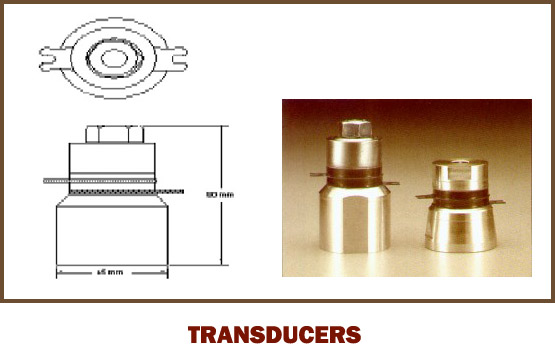
 App.Study Form - Cleaning
App.Study Form - Cleaning |
||||||||||||||||
| Ultrasonic cleaning process overview | ||||||||||||||||
| Ultrasonic cleaning uses high frequency sound waves to agitate in an aqueous or organic spolution. Cavitation bubbles induced by the agitation act on contaminants adhering to substrates like metals, plastics, glass, rubber, and ceramics. This action also penetrates blind holes, cracks, and recesses. The intention is to thoroughly remove all traces of contamination tightly adhering or embedded onto solid surfaces. Water or other solvents can be used, depending on the type of contamination and the type of application The different types of contaminants may be dust, dirt, oil, pigments, grease, polishing compounds, flux agents, fingerprints, soot wax and mold release agents, biological soil like blood, and so on. Ultrasonic cleaning can be used for a wide range of work piece shapes, sizes and materials, and may not require the part to be disassembled prior to cleaning. | ||||||||||||||||
 |
||||||||||||||||
| Types of Applications | ||||||||||||||||
| Materials that can be cleaned include metals, glass, ceramics, and so on. Ultrasonic agitation can be used with a variety of cleaning agents.Ultrasonic cleaners are often used to clean components which may vary from different industries like jewellary, lenses, machine components, watches, surgical instruments, industrial parts and electronic equipment. | ||||||||||||||||
 |
||||||||||||||||
| Design & Operation | ||||||||||||||||
| In an ultrasonic cleaner, the object to be cleaned is placed in a chamber with or without a basket to hold the component containing a suitable solution may be an aqueous or organic solution, depending on the application. In aqueous cleaners, the chemical added is a surfactant which breaks down the surface tension of the water base. An ultrasound generating transducer built into the chamber, or lowered into the fluid, produces ultrasonic waves in the fluid by changing size in concert with an electrical signal oscillating at ultrasonic frequency. This creates compression waves in the liquid of the tank which 'tear' the liquid apart, leaving behind many millions of microscopic 'voids' or 'partial vacuum bubbles' (cavitation). These bubbles collapse with enormous energy with the increase in temperatures & pressures. The lower frequencies create larger bubbles with more energy which lead to lower-frequency cleaners will tend to form larger dents, whereas higher-frequency cleaners form much smaller dents. However, they are so small that they do no more than clean and remove surface dirt and contaminants. The higher the frequency, the smaller the nodes between the cavitation points, which allows for cleaning of more intricate detail. | ||||||||||||||||
| Transducers | ||||||||||||||||
| Transducers are usually made of piezoelectric material magnetostrictive (made of a material such as nickel or ferrite). The often harsh chemicals used as cleaners in many industries are not needed, or used in much lower concentrations, with ultrasonic agitation. Ultrasonics are used for industrial cleaning, and also used in many medical and dental techniques and industrial processes. | ||||||||||||||||
 |
||||||||||||||||
| Cleaning Solutions | ||||||||||||||||
|
Other than Cleaning equipment and procedure, cleaning media play an important role as they eventually remove the contaminants from the substrate. As liquid media the following cleaners are in use: aqueous agents, semi-aqueous agents (an emulsion of solvents and water), hydrocarbon based solvents and halogenated solvents. Usually the latter are referred to as chlorinated agents, but there are also brominated and fluorated substances in (limited) use, that is why we have chosen the higher level classification. The traditionally used chlorinated agents TCI and PCE are nowadays only applied in airtight plants and the modern volume shift systems do hardly permit any emissions. Aqueous cleaners are mostly a combination of various substances like Alkaline builders, surfactants, sequestering agents, etc. In the group of hydrocarbon based solvents there are some newly developed agents like fatty acid esters made of natural fats and oils, modified alcohols and dibasic esters. Aqueous cleaners have advantages as regards particle and polar contaminants but generally need a higher energy input, whereas solvents score in removal of oils and greases but have their health and environmental risks. In addition most of them are flammable and create fire and explosion hazards. Water-based solutions are more limited in their ability to remove contaminants by chemical action alone than solvent solutions; e.g. for delicate parts covered with thick grease. The effort required to design an effective aqueous-cleaning system for a particular purpose is much greater than for a solvent system. |
||||||||||||||||
| Types Contamination | ||||||||||||||||
|
||||||||||||||||
| Different types of cleaning equipments & the techniques | ||||||||||||||||
|
||||||||||||||||
| The Cleaning process may be performed in one single stage or in multistage depending on the level of contamination & application. In multistage sometimes non cleaning stages also integrated like the application of corrosion protection layers or phospating. In some of the cases the cleaning processes are integrated into other processes as it is the case with electroplating or galvanising, where it usually serves as a pre-treatment step. | ||||||||||||||||
| Multistage cleaning stages | ||||||||||||||||
|
||||||||||||||||
| Each of these steps may take place in its own bath or chamber or in a single chamber. | ||||||||||||||||
